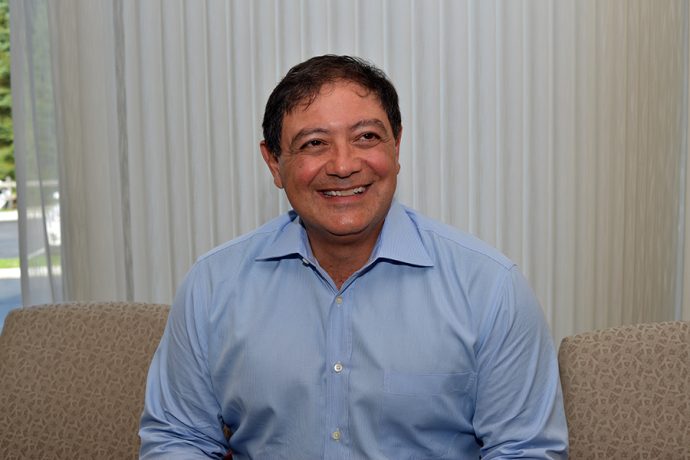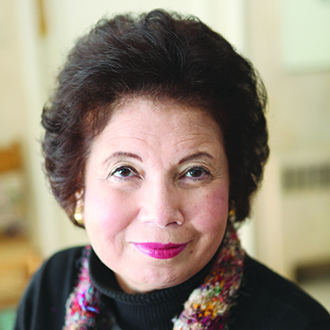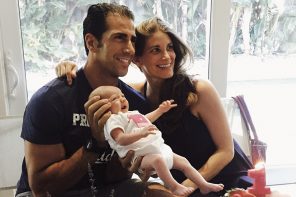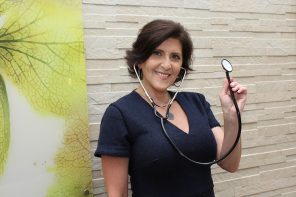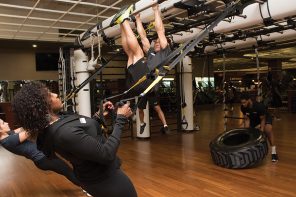Dr. Victor Khabie has always loved sports and medicine.
the University of Pennsylvania and played several other sports. Sports were always a big part of my life and still are.”
Today, he enjoys a flourishing career that marries both passions as an orthopedic surgeon who is chief of surgery and chief of sports medicine at Northern Westchester Hospital in Mount Kisco.
There he has encountered many a promising young athlete with injuries to the ACL (anterior cruciate ligament) of the knee, which connects the femur, or thigh bone, to the tibia in the lower leg. It is a common injury — especially in soccer, football and basketball — and it is on the rise among girls and young women. Untreated, the result can be the end of competitive play and the loss of scholarship money.
Khabie — who holds an M.D. from Harvard Medical School and has been in his field for about 20 years — is distressed by “the young women I see tearing up their ACLs at an alarming rate. ACL injuries have become endemic. The intensity of the way sports are played today stresses young athletes at a high level. Soccer injuries are the most prevalent and most of them affect girls and women.”
STRESS CAN OVERWHELM
He points to the often relentless competitions, sports camps, sports showcases, travel teams and other venues that keep athletes playing continuously and at a high level of intensity without ever taking a break.
“Athletes specialize in sports like soccer at a younger and younger age,” he says. “They are subjecting the same body parts to the same stress over and over without taking time off. Specializing in one sport only has become almost the standard and there is a lack of cross-training, which is very beneficial to the body.”
Khabie adds that an entire industry has developed around these highly specialized young athletes.
“Division I scholarship money requires a very high degree of specification to obtain it.
“The young athletes throw themselves into a high level of specialization, some of them to please their parents and others because of their own inner drive and determination to succeed. It’s now a big money industry that can really put a choke hold on families. I would really like to see a return to the three-letter athletes of my college years, where top athletes played multiple sports. It’s much healthier for the mind and body.”
Khabie says another factor that plays into the equation of increased sports injuries among young people is that the athletes are bigger and stronger. “When they collide, there is a lot more force. Fortunately, elementary and middle school have far fewer injuries, but once the kids get to high school and college, it is a different story.”
The ACL injury rate for women versus men is roughly 3 to 1 or 4 to 1.
“Women today are playing more sports and the female ACL is more susceptible to injury than the male. It is alarming.”
Khabie says he believes sports programs should concentrate more on injury prevention.
First, they should teach more about form and proper technique in their sports. “Poor technique leads to an increase in injuries. Second, coaches must remember young athletes need periods of rest. No one can go on and on without a break. Finally, specialization is a real problem that can be remedied by cross-training in one or more other sports.”
Parents and athletes may also need to make an attitude adjustment about competitive sports. “Being overly driven is not a good thing,” he says. “What if you don’t make it to the top and don’t get that scholarship? And you have to also realize that most athletic talent is innate and cannot be taught. The athletes (who are) naturally gifted will rise to the top and there is a subset that will always be at the second level, no matter how hard they try. People need to think about this.”
INJURY REPAIR
In healing sports injuries, the cutting-edge continues to be the use of the body’s own stem cells to improve the healing process. “Doctors can use platelets-rich plasma from the patient’s own blood supply after separating it and turn it into a healing form. This is then injected into the site of the injury, and we are seeing some very good results. It’s a form of natural healing that is growing in use among older adolescents.”
Research has indicated that to use stem cells as an effective treatment in sports medicine, the cells must recognize where they are and know what they need to do. They then need to change into the types of cells that can form new cartilage or bone or reorganize a damaged tendon.
“I believe these techniques have a great future,” Khabie says. “Anytime we can get the body to heal itself, we have taken a critical step forward.”
# # #
DR. VICTOR KHABIE AT A GLANCE
Profession: Orthopedic surgeon
Title: Chief of surgery and of sports medicine at Northern Westchester Hospital in Mount Kisco.
Education: University of Pennsylvania; Harvard Medical School
Other associations: Assistant clinical professor of orthopedic surgery at the Orthopedic Institute of the Hospital for Joint Diseases at NYU Langone Medical Center. He has participated in the care of the Los Angeles Lakers, Los Angeles Dodgers, Los Angeles Kings, Anaheim Mighty Ducks and many other teams.
He is a ringside physician for the New York State Athletic Commission, where he cares for professional boxers and has been present at ringside for numerous world championship bouts.
Khabie is also with Somers Orthopedic Surgery with locations in Mount Kisco, Caramel, Newburgh and Fishkill. 845-278-8400.
Personal: Khabie lives with his wife, Brenda, and four daughters in Bedford Corners.

